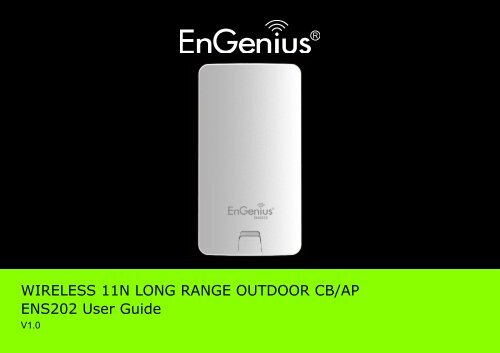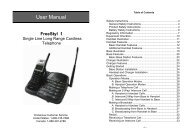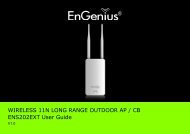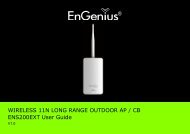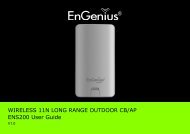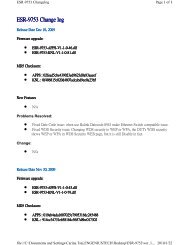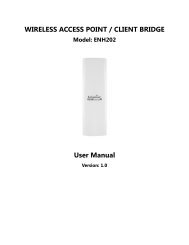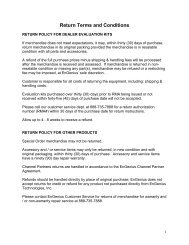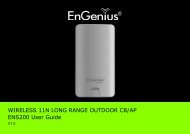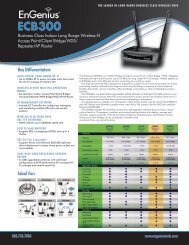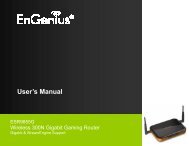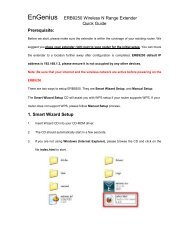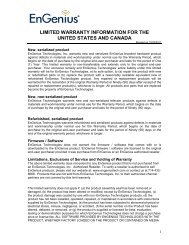ENS202 User Manual - EnGenius Technologies
ENS202 User Manual - EnGenius Technologies
ENS202 User Manual - EnGenius Technologies
You also want an ePaper? Increase the reach of your titles
YUMPU automatically turns print PDFs into web optimized ePapers that Google loves.
WIRELESS 11N LONG RANGE OUTDOOR CB/AP<strong>ENS202</strong> <strong>User</strong> GuideV1.0
TABLE OF CONTENTSTABLE OF CONTENTSConventionsCopyright0-vi0-viiiProduct OverviewPackage Contents 1-1Product Overview 1-2Key Features . . . . . . . . . . . . . . . . . . . . . . . . . . . . . . . . . . . . . . . . . . . . . . . . . . . . . . .1-2Benefits . . . . . . . . . . . . . . . . . . . . . . . . . . . . . . . . . . . . . . . . . . . . . . . . . . . . . . . . . . .1-3Technical Specification . . . . . . . . . . . . . . . . . . . . . . . . . . . . . . . . . . . . . . . . . . . . . . . . .1-4Wireless Specification . . . . . . . . . . . . . . . . . . . . . . . . . . . . . . . . . . . . . . . . . . . . . . . .1-4Hardware Specification . . . . . . . . . . . . . . . . . . . . . . . . . . . . . . . . . . . . . . . . . . . . . . .1-4Software Specification. . . . . . . . . . . . . . . . . . . . . . . . . . . . . . . . . . . . . . . . . . . . . . . .1-4Product Layout 1-5InstallationSystem Requirements 2-1I
TABLE OF CONTENTSInstalling the Device 2-2Pre-Installation Guidelines . . . . . . . . . . . . . . . . . . . . . . . . . . . . . . . . . . . . . . . . . . . . . .2-2Installing the Device . . . . . . . . . . . . . . . . . . . . . . . . . . . . . . . . . . . . . . . . . . . . . . . . . .2-2Web ConfigurationLogging In 3-1Best Practices . . . . . . . . . . . . . . . . . . . . . . . . . . . . . . . . . . . . . . . . . . . . . . . . . . . . . . .3-2Basic Network SettingsSystem Status 4-1Using Save/Reload 4-1Viewing System Information 4-2Viewing Wireless Client List 4-4Viewing System Log 4-5Viewing Connection Status 4-6Viewing DHCP Client Table 4-7Viewing WDS Link List 4-8System Setup 4-9II
TABLE OF CONTENTSConfiguring Operation Mode 4-9Configuring IP Settings 4-10Configuring Spanning Tree Settings 4-11Router Setup 4-12Configuring WAN Settings 4-12Static IP. . . . . . . . . . . . . . . . . . . . . . . . . . . . . . . . . . . . . . . . . . . . . . . . . . . . . . . . . .4-12Dynamic IP. . . . . . . . . . . . . . . . . . . . . . . . . . . . . . . . . . . . . . . . . . . . . . . . . . . . . . . .4-13Point-to-Point Protocol over Ethernet (PPPoE). . . . . . . . . . . . . . . . . . . . . . . . . . . . . . . .4-14Point-to-Point Tunnelling Protocol (PPTP) . . . . . . . . . . . . . . . . . . . . . . . . . . . . . . . . . . .4-15Configuring LAN Settings 4-17Configuring VPN Pass-Through 4-18Configuring Port Forwarding 4-19Configuring Demilitarized Zone 4-21Configuring Wireless LAN 4-22Configuring Wireless Settings 4-22Access Point Mode . . . . . . . . . . . . . . . . . . . . . . . . . . . . . . . . . . . . . . . . . . . . . . . . . . .4-22Client Bridge Mode . . . . . . . . . . . . . . . . . . . . . . . . . . . . . . . . . . . . . . . . . . . . . . . . . .4-24WDS Bridge Mode . . . . . . . . . . . . . . . . . . . . . . . . . . . . . . . . . . . . . . . . . . . . . . . . . . .4-26Client Router Mode . . . . . . . . . . . . . . . . . . . . . . . . . . . . . . . . . . . . . . . . . . . . . . . . . .4-28Configuring Wireless Security 4-30III
TABLE OF CONTENTSWired Equivalent Privacy (WEP) . . . . . . . . . . . . . . . . . . . . . . . . . . . . . . . . . . . . . . . . .4-30Wi-Fi Protected Access Pre-Shared Key (WPA-PSK) . . . . . . . . . . . . . . . . . . . . . . . . . . . .4-31Wi-Fi Protected Access 2 Pre-Shared Key (WPA2-PSK). . . . . . . . . . . . . . . . . . . . . . . . . .4-32Wi-Fi Protected Access Pre-Shared Key (WPA-PSK) Mixed . . . . . . . . . . . . . . . . . . . . . . .4-33Wi-Fi Protected Access (WPA) . . . . . . . . . . . . . . . . . . . . . . . . . . . . . . . . . . . . . . . . . . .4-34Wi-Fi Protected Access 2 (WPA2) . . . . . . . . . . . . . . . . . . . . . . . . . . . . . . . . . . . . . . . .4-35Wi-Fi Protected Access (WPA) Mixed . . . . . . . . . . . . . . . . . . . . . . . . . . . . . . . . . . . . . .4-36Configuring Wireless MAC Filter 4-37Configuring WDS Link Settings 4-38Configuring Advanced Network Settings 4-39Wireless Traffic Shaping. . . . . . . . . . . . . . . . . . . . . . . . . . . . . . . . . . . . . . . . . . . . . . .4-39Client Limit. . . . . . . . . . . . . . . . . . . . . . . . . . . . . . . . . . . . . . . . . . . . . . . . . . . . . . . .4-40Management Setup 4-41Configuring Administrator Account 4-41Configuring Management VLAN 4-42Configuring SNMP 4-43Configuring Backup/Restore Settings 4-45Configuring Auto Reboot Settings 4-46Configuring Firmware Upgrade 4-47Configuring System Time 4-48IV
TABLE OF CONTENTSConfiguring Wi-Fi Schedule 4-49Add a Schedule Service . . . . . . . . . . . . . . . . . . . . . . . . . . . . . . . . . . . . . . . . . . . . . . .4-49Schedule Services Table. . . . . . . . . . . . . . . . . . . . . . . . . . . . . . . . . . . . . . . . . . . . . . .4-50Configuring Command Line Interface 4-51Configuring Logging 4-52Configuring Diagnostics 4-53Viewing Device Discovery 4-54Configure Denial of Service Protection 4-55Logging Out 4-56Appendix AFederal Communication Commission Interference Statement A-1Appendix BIndustry Canada Statement B-1Appendix CWorldWide Technical Support C-1V
CONVENTIONSConventionsThe following conventions are used to give the user additionalinformation about specific procedures or content. It is importantto pay attention to these conventions as they provide informationto prevent damage to equipment or personal injury.General ConventionsThe following general conventions are used in this document.!CAUTION!CAUTIONS APPEAR BEFORE THE TEXT IT REFERENCES. CAU-TIONS APPEAR IN CAPITAL LETTERS TO EMPHASIZE THAT THEMESSAGE CONTAINS VITAL HEALTH AND SAFETY INFORMATION.N/A:Example:Indicates information used to demonstrate or explain anassociated concept.Indicates that a component or a procedure is not applicableto this model.Prerequisite:Indicates a requirement that must be addressed beforeproceeding with the current function or procedure.!WARNING!Warning information appears before the text it referencesto emphasize that the content may prevent damage to thedevice or equipment.Important:Indicates information that is important to know for theproper completion of a procedure, choice of an option, orcompleting a task.Note:Indicates additional information that is relevant to the currentprocess or procedure.VI
CONVENTIONSTypographical ConventionsThe following typographical conventions are used in this document:ItalicsIndicates book titles, directory names, file names, path names,and program/process names.Constant widthIndicates computer output shown on a computer screen, includingmenus, prompts, responses to input, and error messages.Constant width boldIndicates commands lines as entered on the computer. Variablescontained within user input are shown in anglebrackets (< >).BoldIndicates keyboard keys that are pressed by the user.VII
COPYRIGHTCopyrightThis user guide and its content is copyright of © <strong>EnGenius</strong> Networks,2011. All rights reserved.Any redistribution or reproduction in part or in whole in any formis prohibited.Do not distribute, transmit, store in any form of electronicretrieval system or commercially exploit the content without theexpressed written permission of <strong>EnGenius</strong> Networks.VIII
Product OverviewChapter 1
PRODUCT OVERVIEWPACKAGE CONTENTS1.1 Package Contents• <strong>ENS202</strong>• Quick Start Guide• Technical Support Card• Pole Mounting Strap x2• Wall Mounting Screw Set• PoE Injector (EPE-1212) with Power Adapter1-1
PRODUCT OVERVIEWPRODUCT OVERVIEW1.2 Product OverviewThank you for choosing <strong>ENS202</strong>. The <strong>ENS202</strong> is a long range,high performance IEEE 802.11b/g/n network solution that providesAccess Point, Client Bridge, WDS, and Client Routerfunctions in a single device.In addition to providing the latest wireless technology, the<strong>ENS202</strong> supports Power over Ethernet and Power by Adaptercapabilities, which allow the device to be installed easily innearly any indoor or outdoor location. Advanced featuresinclude power level control, traffic shaping, and Real time RSSIindication.A variety of security features help to protect your data and privacywhile you are online. Security features include Wi-Fi ProtectedAccess (WPA PSK/WPA2 PSK), 64/128/156 bit WEPEncryption, and IEEE 802.1x with RADIUS.Key Features• High-speed data rates up to 300 Mbps make the <strong>ENS202</strong>ideally suited for handling heavy data payloads such asMPEG video streaming• High output power up to 26 dBm delivers superior rangeand coverage• Fully Interoperable with IEEE 802.11b/IEEE 802.11g/IEEE802.11n-compliant devices• Multi-function capabilities enable users to use differentmodes in various environments• Point-to-point and point-to-multipoint wireless connectivityenable data transfers between two or more buildings• Channel bandwidth selection allows the appropriate bandwidthto be used to reach various distances• RSSI indicator makes it easy to select the best signal forAccess Point connections• Power-over-Ethernet capabilities allow for flexible installationlocations and cost savings• Four SSIDs let clients access different networks through asingle Access Point, and assign different policies andfunctions for each SSID• WPA2/WPA/ WEP/ IEEE 802.1x support and MACaddress filtering ensure secure network connections• PPPoE/PPTP function support make it easy to access theInternet via Internet Service Provider (ISP) serviceauthentication• SNMP Remote Configuration Management helps administratorsremotely configure or manage the Access Point• QoS (WMM) support enhances performance and userexperiences1-2
PRODUCT OVERVIEWBENEFITSBenefitsThe <strong>ENS202</strong> is the ideal product around which you can buildyour WLAN. The following list summarizes a few key advantagesthat WLANs have over wired networks:Ideal for hard-to-wire environmentsThere are many scenarios where cables cannot be used to connectnetworking devices. Historic and older buildings, openareas, and busy streets, for example, make wired LAN installationsdifficult, expensive, or impossible.Temporary workgroupsWLANs make it easy to provide connectivity to temporary workgroupsthat will later be removed. Examples include parks, athleticarenas, exhibition centers, disaster-recovery shelters,temporary offices, and construction sites.Ability to access real-time informationWireless extensions to Ethernet networksWLANs enable network managers in dynamic environments tominimize overhead caused by moves, extensions to networks,and other changes.Wired LAN backupNetwork managers can implement WLANs to provide backupfor mission-critical applications running on wired networks.Mobility within training/educationalfacilitiesTraining sites at corporations and students at universities are afew examples where wireless connectivity can be used to facilitateaccess to information, information exchanges, and learning.With a WLAN, workers who rely on access to real-time information,such as doctors and nurses, point-of-sale employees,mobile workers, and warehouse personnel, can access the datathey need and increase productivity, without having to look for aplace to plug into the network.Frequently changed environmentsWLANs are well suited for showrooms, meeting rooms, retailstores, and manufacturing sites where workplaces are rearrangedfrequently.1-3
PRODUCT OVERVIEWTECHNICAL SPECIFICATIONTechnical SpecificationWireless Specification• IEEE802.11b/g/n, 2T2R, 300Mbps• 2.400 to 2.484 GHz, programmable upon different countryregulationsHardware Specification• Physical Interface: 2 x 10/100Mbps LAN Ports, 1 x ResetButton• Power Supply: Passive PoE, 24V/0.6A Power Adapter• Dimension: 186mm(L) x 100mm(W) x 29mm(H)• Operation Temperature: -20°C ~ 70°C• Embedded high gain directional antennaSoftware Specification• Operation Mode: Client Bridge, Access Point, ClientRouter, WDS AP, WDS Bridge, WDS Station• Multiple SSID, Preferred SSID• PPPoE, PPTP, L2TP Pass-through• WMM, Traffic Shaping• CLI Interface, SNMP v1/v2c/v3• Recovery Page• Port Forwarding/DMZ1-4
PRODUCT OVERVIEWPRODUCT LAYOUT1.3 Product LayoutBACK PANEL VIEWDESCRIPTIONAPower LEDOFF = <strong>ENS202</strong> is not receiving powerON = <strong>ENS202</strong> is receiving powerBLAN (2) LEDsOFF = <strong>ENS202</strong> is not connected to thenetwork.ON = <strong>ENS202</strong> is connected to the network,but not sending or receiving dataBlink = <strong>ENS202</strong> is sending or receiving dataCWLAN LED(Access Point or Client Bridge Mode)OFF = <strong>ENS202</strong> radio is off and the device isnot sending or receiving data over thewireless LAN.ON = <strong>ENS202</strong> radio is on, and the device isnot sending or receiving data over thewireless LAN.Blinking = <strong>ENS202</strong> radio is on, and thedevice is sending or receiving data over thewireless LAN.A B C DDSignal Indicator LED(Client Bridge, WDS Station and ClientRouter Mode)Green - Signal is goodOrange - Signal is normalRed - Signal is weak or non-existentFigure 1-1: Back Panel View1-5
PRODUCT OVERVIEWPRODUCT LAYOUTA B CABCBOTTOM VIEWReset ButtonLAN ConnectorPoE LAN ConnectorDESCRIPTIONTo reset to factory settings, press button for >10 seconds.To configure the <strong>ENS202</strong>, connect to anEthernet adapter in a computer. For moreinformationThe PoE interface allows the <strong>ENS202</strong> to bepowered using the supplied PoE injector1-6
InstallationChapter 2
INSTALLATIONSYSTEM REQUIREMENTS2.1 System RequirementsTo install the <strong>ENS202</strong>, you need the following:• ComputComputer (Windows, Linux, Mac OS X OperatingSystem)• Web Browser (Internet Explorer, FireFox, Chrome, Safari)• Network Interface equipped: (one of the following)• Wired connectivity: Network Interface with an openRJ-45 Ethernet Port• Wireless Connectivity:• Embedded 802.11n Wi-Fi wireless networking, IEEE802.11a/b/g compatible• Wi-Fi Card, USB Wi-Fi Dongle (802.11 b/g/n)• An existing router or access point (AP) with SSID broadcast• 1x CAT5e Ethernet Cable2-1
INSTALLATIONINSTALLING THE DEVICE2.2 Installing the DeviceInstalling the <strong>ENS202</strong> on a pole or wall optimizes the wirelessaccess range.Note:Only experienced installation professionals who are familiarwith local building and safety codes and, whereverapplicable, are licensed by the appropriate governmentregulatory authorities should install the <strong>ENS202</strong>.Pre-Installation GuidelinesSelect the optimal location for the equipment using the followingguidelines:• The <strong>ENS202</strong> should be mounted on a 1"-4" pole. Its locationshould enable easy access to the unit and its connectorsfor installation and testing.• The higher the placement of the antenna, the better theachievable link quality.• The antenna should be installed to provide a direct, ornear line of sight with the Base Station antenna. Theantenna should be aligned to face the general direction ofthe Base Station.Installing the DeviceTo install the <strong>ENS202</strong>, use the following procedure to mount thedevice on a pole and refer to the figure below.1. Remove the bottom cover protecting the RJ-45 connectors.2. Insert an Ethernet cable into the RJ-45 port labeled LAN.3. Install the bottom cover to protect the RJ-45 connectors.4. Remove the power cord and PoE injector from the boxand plug the power cord into the DC port of the PoE injector.!CAUTION!ONLY USE THE POWER ADAPTER SUPPLIED WITH THE<strong>ENS202</strong>. USING A DIFFERENT POWER ADAPTER MIGHTDAMAGE THE <strong>ENS202</strong>.2-2
INSTALLATIONINSTALLING THE DEVICE5. Plug the other end of the Ethernet cable into the PoE portof the PoE injector.PoELANFigure 2-1: Installing the <strong>ENS202</strong>6. Turn over the <strong>ENS202</strong>. Then insert the pole mountingstrap through the middle hole of the <strong>ENS202</strong>. Use ascrewdriver to unlock the pole-mounting ring putting itthrough the <strong>ENS202</strong>.7. Mount the <strong>ENS202</strong> securely to the pole by locking thestrap tightly.This completes the installation procedure.2-3
Web ConfigurationChapter 3
WEB CONFIGURATIONLOGGING IN3.1 Logging InThe <strong>ENS202</strong> has a built-in Web Configurator that lets youmanage the unit from any location using a Web browser thatsupports HTTP and has Javascript installed.After configuring the computer for TCP/IP using the procedureappropriate for your operating system, use that computer’sWeb browser to log in to the <strong>ENS202</strong> Web Configurator.1. Launch your Web browser.2. In the browser address bar, type 192.168.1.1 andpress the Enter key.Note:If you changed the <strong>ENS202</strong> LAN IP address, enter the correctIP address.3. When the login screen appears, enter admin for the usernamein the top field and admin for the password in the bottomfield.Figure 3-2: Windows Security Login Dialog4. Click Login to continue or Reset to abort the login.You are now ready to use the instructions in the following chaptersto configure the <strong>ENS202</strong>.Figure 3-1: Web Browser Address Bar3-1
WEB CONFIGURATIONBEST PRACTICESBest PracticesPerform the following procedures regularly to make the<strong>ENS202</strong> more secure and manage the <strong>ENS202</strong> more effectively.• Change the default password Use a password that isnot easy to guess and that contains different characters,such as numbers and letters. The <strong>ENS202</strong> username cannotbe changed. For more information, see ConfiguringAdministrator Account.• Back up the configuration and be sure you know how torestore it. Restoring an earlier working configuration canbe useful if the <strong>ENS202</strong> becomes unstable or crashes. Ifyou forget your password, you will have to reset the<strong>ENS202</strong> to its factory default settings and lose any customizedoverride settings you configured. However, if youback up an earlier configuration, you will not have to completelyreconfigure the <strong>ENS202</strong>. You can simply restoreyour last configuration. For more information, see ConfiguringBackup/Restore Settings.3-2
Basic Network SettingsChapter 4
BASIC NETWORK SETTINGSSYSTEM STATUS4.1 System StatusView the summary of the current system status including system (hardware/software version, date/time), wired network (LAN) andwireless network (WLAN) information.4.1.1 Using Save/ReloadSave and apply the settings shown in the Unsaved changes list,or cancel the unsaved changes and revert to the previous settingsthat were in effect.4-1
BASIC NETWORK SETTINGSVIEWING SYSTEM INFORMATION4.1.2 Viewing System InformationDisplays status information about the current operating mode.System Information shows the general system informationsuch as operating mode, system up time, firmware version, serialnumber, kernel version, and application version.LAN Settings shows Local Area Network settings such as theLAN IP address, subnet mask, and MAC address.4-2
BASIC NETWORK SETTINGSVIEWING SYSTEM INFORMATIONWAN Settings shows Wide Area Network settings such as theMAC address, connection type, connection status, LAN IPaddress, subnet mask, primary and secondary DNS.Current Wireless Settings shows wireless information such asfrequency and channel. Since the <strong>ENS202</strong> supports multiple-SSIDs, information about each SSID, such as its ESSID andsecurity settings, are displayed.4-3
BASIC NETWORK SETTINGSVIEWING WIRELESS CLIENT LIST4.1.3 Viewing Wireless Client ListDisplays a list of clients associated to the <strong>ENS202</strong>, along with the MAC addresses and signal strength for each client. To remove anSSID client from the list, click the button that appears in the Kick and Ban column.Click the Refresh button to update the client list.4-4
BASIC NETWORK SETTINGSVIEWING SYSTEM LOG4.1.4 Viewing System LogThe <strong>ENS202</strong> automatically logs events to internal memory.Note:The oldest events are deleted from the log when memory is full.Click the Refresh button to update the client list or the Clear button to remove all events.4-5
BASIC NETWORK SETTINGSVIEWING CONNECTION STATUS4.1.5 Viewing Connection StatusDisplays the current status of the network.The WLAN information shown includes network type, SSID, BSSID, connection status, wireless mode, current channel, security, datarate, noise level, and signal strength.The WAN information shown includes the MAC address, connection type, connection status, IP address, IP subnet mask, primaryDNS and secondary DNS.Click the Refresh button to update the client list or the Clear button to remove all events.4-6
BASIC NETWORK SETTINGSVIEWING DHCP CLIENT TABLE4.1.6 Viewing DHCP Client TableDisplays the clients that are associated to the <strong>ENS202</strong> through DHCP. The MAC addresses and signal strength for each client arealso shown.Click the Refresh button to update the client list.4-7
BASIC NETWORK SETTINGSVIEWING WDS LINK LIST4.1.7 Viewing WDS Link ListDisplays the clients that are associated to the <strong>ENS202</strong> through WDS. The MAC addresses, link status and signal strength for eachclient are also shown.Click the Refresh button to update the client list.4-8
BASIC NETWORK SETTINGSSYSTEM SETUP4.2 System SetupThe following sections explain the features and functionality of the <strong>ENS202</strong> in access point mode, client bridge mode, WDS accesspoint mode, WDS bridge mode, WDS station mode and client router mode.4.2.1 Configuring Operation ModeSet the primary function of the device. The function that is selected affects which items are available in the main menu.Device Name Enter a name for the device. The name you typeappears in SNMP management. This name is not the SSID andis not broadcast to other devices.Country/Region Select a Country/Region to conform to localregulations.Operation Mode Use the radio button to select an operatingmode.Click Save & Apply to save changes or Cancel to abort.4-9
BASIC NETWORK SETTINGSCONFIGURING IP SETTINGS4.2.2 Configuring IP SettingsConfigure the <strong>ENS202</strong> LAN settings for the <strong>ENS202</strong> using a static or dynamic IP address.IP Network Setting Configure the network connection type usingeither a static IP or dynamic IP.IP Address Enter the LAN IP address of the <strong>ENS202</strong>.Subnet Mask Enter the subnet mask of the <strong>ENS202</strong>.Default Gateway Enter the default gateway of the <strong>ENS202</strong>.Primary DNS Enter the primary DNS address of the <strong>ENS202</strong>.Secondary DNS Enter the secondary DNS address of the<strong>ENS202</strong>.Use Link-Local Address Click to enable a link-local address forthe device.IPv6 IP Address Enter the IPv6 LAN IP address of the <strong>ENS202</strong>.IPv6 Subnet Prefix Length Enter the IPv6 subnet prefix length ofthe <strong>ENS202</strong>.IPv6 Default Gateway Enter the IPv6 default gateway of the<strong>ENS202</strong>.IPv6 Primary DNS Enter the IPv6 primary DNS of the <strong>ENS202</strong>.IPv6 Secondary DNS Enter the IPv6 secondary DNS of the <strong>ENS202</strong>.Click Apply to save the settings or Cancel to discard changes.4-10
BASIC NETWORK SETTINGSCONFIGURING SPANNING TREE SETTINGS4.2.3 Configuring Spanning Tree SettingsSpanning Tree Status Enable or disable the <strong>ENS202</strong> SpanningTree function.Bridge Hello Time Specify Bridge Hello Time, in seconds. Thisvalue determines how often the <strong>ENS202</strong> sends hello packets tocommunicate information about the topology throughout theentire Bridged Local Area NetworkBridge Max Age Specify Bridge Max Age, in seconds. If anotherbridge in the spanning tree does not send a hello packet for along period of time, it is assumed to be dead.Bridge Forward Delay Specify Bridge Forward Delay, inseconds. Forwarding delay time is the time spent in each of theListening and Learning states before the Forwarding state isentered. This delay is provided so that when a new bridge comesonto a busy network, it looks at some traffic before participating.Priority Specify the Priority number. Smaller numbers have greater priority.Click Accept to confirm the changes or Cancel to cancel and return previous settings.4-11
BASIC NETWORK SETTINGSROUTER SETUP4.3 Router Setup4.3.1 Configuring WAN SettingsConfigure the WAN settings for the <strong>ENS202</strong> using a static or dynamic IP address, PPPoE or PPTP.Static IPSetting a static IP address allows an administratorto set a specific IP address for the router and guaranteesthat it can not be assigned a differentaddress.Account Name Enter the account name providedby your ISP.Domain Name Enter the domain name providedby your ISP.MTU The maximum transmission unit (MTU)specifies the largest packet size permitted for aninternet transmission. The factory default MTU sizefor static IP is 1500. The MTU size can be setbetween 576 and 1500.IP Address Enter the router’s WAN IP address.Subnet Mask Enter the router’s WAN subnetmask.Default Gateway Enter the WAN gateway address.Primary DNS Enter the primary DNS server address.4-12
BASIC NETWORK SETTINGSDYNAMIC IPSecondary DNS Enter the secondary DNS server address.Discard Ping on WAN Check to Enable to recognize pings on the <strong>ENS202</strong> WAN interface or Disable to block pings on the <strong>ENS202</strong>WAN interface. Note: Pinging IP addresses is a common method used by hackers to test whether the IP address is valid. Blockingpings provides some extra security from hackers.Click Accept to save the settings or Cancel to discard changes.Dynamic IPDynamic IP addressing assigns a different IPaddress each time a device connects to an ISPservice provider. The service is most commonlyused by ISP cable providers.Account Name Enter the account name providedby your ISP.Domain Name Enter the domain name providedby your ISP.MTU The maximum transmission unit (MTU)specifies the largest packet size permitted for aninternet transmission. The factory default MTU sizefor Dynamic IP is 1500. The MTU size can be setbetween 576 and 1500.Get Automatically From ISP Click the radio button to obtain the DNS automatically from the DHCP server.Use These DNS Servers Click the radio button to set up the Primary DNS and Secondary DNS servers manually.Discard Ping on WAN Check to Enable to recognize pings on the <strong>ENS202</strong> WAN interface or Disable to block pings on the <strong>ENS202</strong>WAN interface. Note: Pinging IP addresses is a common method used by hackers to test whether the IP address is valid. Blockingpings provides some extra security from hackers.Click Accept to save the settings or Cancel to discard changes.4-13
BASIC NETWORK SETTINGSPOINT-TO-POINT PROTOCOL OVER ETHERNET (PPPOE)Point-to-Point Protocol over Ethernet (PPPoE)Point-to-Point Protocol over Ethernet (PPPoE) isused mainly by ISPs that provide DSL modems toconnect to the Internet.MTU Enter the maximum transmission unit (MTU).The MTU specifies the largest packet sizepermitted for an internet transmission (PPPoEdefault: 1492). The MTU size can be set between576 and 1492.Login Enter the username assigned by an ISP.Password Enter the password assigned by anISP.Service Name Enter the service name of an ISP(optional).Connect on Demand Select the radio button tospecify the maximum idle time. Internet connectionwill disconnect when it reach the maximum idletime, but it will automatically connect when user tries to access the network.Keep Alive Select whether to keep the Internet connection always on, or enter a redial period once the internet lose connection.Get Automatically From ISP Click the radio button to obtain the DNS automatically from the ISP.Use These DNS Servers Click the radio button to set up the Primary DNS and Secondary DNS servers manually.Discard Ping on WAN Check to Enable to recognize pings on the <strong>ENS202</strong> WAN interface or Disable to block pings on the <strong>ENS202</strong>WAN interface. Note: Pinging IP addresses is a common method used by hackers to test whether the IP address is valid. Blockingpings provides some extra security from hackers.Click Accept to save the settings or Cancel to discard changes.4-14
BASIC NETWORK SETTINGSPOINT-TO-POINT TUNNELLING PROTOCOL (PPTP)Point-to-Point Tunnelling Protocol (PPTP)The point-to-point tunnelling protocol (PPTP) isused in association with virtual private networks(VPNs). There a two parts to a PPTP connection:the WAN interface settings and the PPTP settings.MTU Enter the maximum transmission unit (MTU).The MTU specifies the largest packet sizepermitted for an internet transmission (PPPoEdefault: 1400). The MTU size can be set between1200 and 1400.IP Address Enter the router’s WAN IP address.Subnet Mask Enter the router’s WAN subnet IPaddress.Default Gateway Enter the router’s WAN gatewayIP address.PPTP Server Enter the IP address of the PPTPserver.<strong>User</strong>name Enter the username provided by yourISP.Password Enter the password provided by your ISP.Connect on Demand If you want the <strong>ENS202</strong> to end the Internet connection after it has been inactive for a period of time, select thisoption and enter the number of minutes you want that period of inactivity to last.Keep Alive If you want the <strong>ENS202</strong> to periodically check your Internet connection, select this option. Then specify how often youwant the <strong>ENS202</strong> to check the Internet connection. If the connection is down, the <strong>ENS202</strong> automatically re-establishes yourconnectionGet Automatically From ISP Obtains the DNS automatically from ISP.4-15
BASIC NETWORK SETTINGSPOINT-TO-POINT TUNNELLING PROTOCOL (PPTP)Use These DNS Servers Click the radio button to set up the Primary DNS and Secondary DNS servers manually.Discard Ping on WAN Check to Enable to recognize pings on the <strong>ENS202</strong> WAN interface or Disable to block pings on the <strong>ENS202</strong>WAN interface. Note: Pinging IP addresses is a common method used by hackers to test whether the IP address is valid. Blockingpings provides some extra security from hackers.Click Accept to save the settings or Cancel to discard changes.4-16
BASIC NETWORK SETTINGSCONFIGURING LAN SETTINGS4.3.2 Configuring LAN SettingsIP Address Enter the LAN port IP address.IP Subnet Mask Enter the LAN IP subnet mask.WINS Server IP Enter the WINS Server IP.Use Router As DHCP Server Check this option to enable the<strong>ENS202</strong> internal DHCP server.Starting IP Address Specify the starting IP address range forthe pool of allocated for private IP addresses. The starting IPaddress must be on the same subnet as the ending IP address;that is the first three octets specified here must be the same asthe first three octets in End IP Address.Ending IP Address Specify the ending IP address range for thepool of allocated for private IP addresses. The ending IP addressmust be on the same subnet as the starting IP address; that isthe first three octets specified here must be the same as the firstthree octets in Start IP Address.WINS Server IP Enter the IP address of the WINS server.Click Accept to confirm the changes or Cancel to cancel and return previous settings.4-17
BASIC NETWORK SETTINGSCONFIGURING VPN PASS-THROUGH4.3.3 Configuring VPN Pass-ThroughVPN Pass-through allows a secure virtual private network (VPN) connection between two computers. Enabling the options on thispage opens a VPN port and enables connections to pass through the <strong>ENS202</strong> without interruption.PPTP Pass-through Check this option to enable PPTP pass-through mode.L2TP Pass-through Check this option to enable L2TP pass-through mode.IPSec Pass-through Check this option to enable IPSec pass-through mode.Click Accept to confirm the changes or Cancel to cancel and return previous settings.4-18
BASIC NETWORK SETTINGSCONFIGURING PORT FORWARDING4.3.4 Configuring Port ForwardingPort forwarding enables multiple server applications on a LAN to serve clients on a WAN over a single WAN IP address. The routeraccepts incoming client packets, filters them based on the destination WAN, or public, port and protocol and forwards the packets tothe appropriate LAN, or local, port. Unlike the DMZ feature, port forwarding protects LAN devices behind the firewall.NO. Displays the sequence number of the forwarded port.Name Displays the name of the forwarded port.Protocol Displays the protocol to use for mapping from the following: TCP, UDP or Both.Start Port Displays the LAN port number that WAN client packets will be forward to.End Port Displays the port number that the WAN client packets are received.Server IP Displays the IP address of the server for the forwarded port.Enable Click to enable or disable the forwarded port profile.Modify Click to modify the forwarded port profile.Delete Click to delete the forwarded port profile.Click Add Entry to add port forwarding rules.Click Accept to confirm the changes.4-19
BASIC NETWORK SETTINGSCONFIGURING PORT FORWARDINGService Name Enter a name for the port forwarding rule.Protocol Select a protocol for the application: Choices are Both, TCP, and UDP.Starting Port Enter a starting port number.Ending Port Enter an ending port number. All ports numbers between the starting andending ports will forward users to the IP address specified in the IP Address field.IP Address Enter the IP address of the server computer on the LAN network whereusers will be redirected.Click Save to apply the changes or Cancel to return previous settings.4-20
BASIC NETWORK SETTINGSCONFIGURING DEMILITARIZED ZONE4.3.5 Configuring Demilitarized ZoneConfiguring a device on the LAN as a demilitarized zone (DMZ) host allows unrestricted two-way Internet access for Internet applications,such as online video games, to run from behind the NAT firewall. The DMZ function allows the router to redirect all packetsgoing to the WAN port IP address to a particular IP address on the LAN. The difference between the virtual server and the DMZ functionis that a virtual server redirects a particular service or Internet application, such as FTP, to a particular LAN client or server,whereas a DMZ redirects all packets, regardless of the service, going to the WAN IP address to a particular LAN client or server.!WARNING!The PC defined as a DMZ host is not protected by the firewall and is vulnerable to malicious network attacks. Do not store or managesensitive information on the DMZ host.DMZ Hosting Select Enable DMZ to activate DMZ functionality.DMZ Address Enter an IP address of a device on the LAN.Click Accept to confirm the changes or Cancel to cancel andreturn previous settings.4-21
BASIC NETWORK SETTINGSCONFIGURING WIRELESS LAN4.4 Configuring Wireless LAN4.4.1 Configuring Wireless SettingsInstructions on how to configure the wireless and security settings for each of the possible operating modes.!WARNING!Incorrectly changing these settings may cause the device to stop functioning. Do not modify the settings in this section without a thoroughunderstanding of the parameters.Access Point ModeThe <strong>ENS202</strong> supports Access Point Mode. In this mode, users with a wireless client device within range can connect to the <strong>ENS202</strong>to access the WLAN.Wireless Mode Wireless mode supports 802.11b/g/n mixed modes.Channel HT Mode The default channel bandwidthis 20/40 MHz. The larger the channel, the betterthe transmission quality and speed.Extension Channel Select upper or lowerchannel. Your selection may affect the Autochannel function.Channel / Frequency Select the channel andfrequency appropriate for your country’sregulation.Auto Check this option to enable auto-channel selection.4-22
BASIC NETWORK SETTINGSACCESS POINT MODEAP Detection AP Detection can select the best channel to use by scanning nearby areas for Access Points.Current Profile Configure up to four different SSIDs. If many client devices will be accessing the network, you can arrange thedevices into SSID groups. Click Edit to configure the profile and check whether you want to enable extra SSIDs.Click Accept to confirm the changes or Cancel to cancel and return previous settings.SSID Specify the SSID for the current profile.VLAN ID Specify the VLAN tag for the current profile.Suppressed SSID Check this option to hide the SSID fromclients. If checked, the SSID will not appear in the site survey.Station Separation Click the appropriate radio button to allowor prevent communication between client devices.Wireless Security See the Wireless Security section.Click Save to accept the changes or Cancel to cancel andreturn previous settings.4-23
BASIC NETWORK SETTINGSCLIENT BRIDGE MODEClient Bridge ModeClient Bridge Mode lets you connect two LAN segments via a wireless link as though they are on the same physical network. Sincethe computers are on the same subnet, broadcasts reach all machines. As a result, DHCP information generated by the server reachall client computers as though the clients residing on one physical network.Wireless Mode Wireless mode supports 802.11b/g/n mixed modes.SSID Specify the SSID if known. This field iscompleted automatically if you select an AccessPoint in the Site Survey.Site Survey Scans nearby locations for AccessPoints. You can select a discovered Access Pointto establish a connection.Prefer BSSID Enter the MAC address if known. Ifyou select an Access Point in the Site Survey, thisfield is completed automatically.Wireless Security For details on wireless security settings, see Configuring Wireless Security.Click Accept to confirm the changes or Cancel to cancel and return previous settings.4-24
BASIC NETWORK SETTINGSCLIENT BRIDGE MODEProfile If you used the Site Survey, the WebConfigurator shows nearby Access Points. Toconnect to an Access Point, click the AccessPoint’s BSSID.Wireless Security See Configuring WirelessSecurity.Click Refresh to scan again.4-25
BASIC NETWORK SETTINGSWDS BRIDGE MODEWDS Bridge ModeUnlike traditional bridging. WDS Bridge Mode allows you to create large wireless networks by linking several wireless access pointswith WDS links. WDS is normally used in large, open areas, where pulling wires is cost prohibitive, restricted or physically impossible.Wireless Mode Wireless mode supports 802.11b/g/n mixedmodes.Channel HT Mode The default channel bandwidth is 40 MHz.The larger the channel, the better the transmission quality andspeed.Extension Channel Select upper or lower channel. Yourselection may affect the Auto channel function.Channel / Frequency Select the channel and frequencyappropriate for your country’s regulation.Click Accept to confirm the changes or Cancel to cancel andreturn previous settings.4-26
BASIC NETWORK SETTINGSWDS BRIDGE MODESecurity Select the type of WDS security: None,WEP, or AES.WEP Key Enter the WEP key.AES Pass phrase Enter the AES pass phrase.MAC Address Enter the MAC address of theAccess Point to which you want to extend wirelessconnectivity.Mode Select Disable or Enable to disable orenable WDS.Click Accept to confirm the changes or Cancel tocancel and return previous settings.4-27
BASIC NETWORK SETTINGSCLIENT ROUTER MODEClient Router ModeIn Client Router Mode, you can access the Internet wirelessly with the support of a WISP. In AP Router Mode, the <strong>ENS202</strong> canaccess the Internet via a cable or DSL modem. In this mode, the <strong>ENS202</strong> can be configured to turn off the wireless network name(SSID) broadcast, so that only stations that have the SSID can be connected. The <strong>ENS202</strong> also provides wireless LAN 64/128/156-bit WEP encryption security, WPA/WPA2, and WPA-PSK/WPA2-PSK authentication, as well as TKIP/AES encryption security. It alsosupports VPN pass-through for sensitive data secure transmission.Wireless Mode Wireless mode supports 802.11b/g/n mixed modes.SSID Specify the SSID if known. This field iscompleted automatically if you select an AccessPoint in the Site Survey.Site Survey Scans nearby locations for AccessPoints. You can select a discovered Access Pointto establish a connection.Prefer BSSID Enter the MAC address if known. Ifyou select an Access Point in the Site Survey, thisfield is completed automatically.Wireless Security See Configuring Wireless Security.Click Accept to confirm the changes or Cancel to cancel and return previous settings.4-28
BASIC NETWORK SETTINGSCLIENT ROUTER MODEProfile If you used the Site Survey, the WebConfigurator shows nearby Access Points. Toconnect to an Access Point, click the AccessPoint’s BSSID.Wireless Security See Configuring WirelessSecurity.Click Refresh to scan again.4-29
BASIC NETWORK SETTINGSCONFIGURING WIRELESS SECURITY4.4.2 Configuring Wireless SecurityThe Wireless Security Settings section lets you configure the <strong>ENS202</strong>’s security modes: WEP, WPA-PSK, WPA2-PSK, WPA-PSKMixed, WPA, WPA2, and WPA Mixed. We strongly recommend you use WPA2-PSK.Wired Equivalent Privacy (WEP)Security Mode Select WEP from the drop-down list to begin theconfiguration.Auth Type Select Open System or Shared.Input Type Select an input type of Hex or ASCII.Key Length Level of WEP encryption applied to all WEP keys.Select a 64/128/152-bit password lengths.Default Key Specify which of the four WEP keys the <strong>ENS202</strong>uses as its default.Key1 - Key4 Specify a password for the security key index. Forsecurity, each typed character is masked by a dot.Click Save to save the changes or Cancel to cancel and returnprevious settings.Note:802.11n does not allow WEP/WPA-PSK TKIP/WPA2-PSK TKIP security mode. The connection mode will change from 802.11n to802.11g.4-30
BASIC NETWORK SETTINGSWI-FI PROTECTED ACCESS PRE-SHARED KEY (WPA-PSK)Wi-Fi Protected Access Pre-Shared Key (WPA-PSK)Security Mode Select WPA-PSK from the drop-down list tobegin the configuration.Encryption Select Both, TKIP, or AES as the encryption type.• Both = uses TKIP and AES.• TKIP = automatic encryption with WPA-PSK; requires passphrase.• AES = automatic encryption with WPA2-PSK; requirespassphrase.Passphrase Specify the security password. For security, each typed character is masked by a dot.Group Key Update Interval Specify how often, in seconds, the group key changes.Click Save to save the changes or Cancel to cancel and return previous settings.Note:802.11n does not allow WEP/WPA-PSK TKIP/WPA2-PSK TKIP security mode. The connection mode will change from 802.11n to802.11g.4-31
BASIC NETWORK SETTINGSWI-FI PROTECTED ACCESS 2 PRE-SHARED KEY (WPA2-PSK)Wi-Fi Protected Access 2 Pre-Shared Key (WPA2-PSK)Security Mode Select WPA2-PSK from the drop-down list tobegin the configuration.Encryption Select Both, TKIP, or AES as the encryption type.• Both = uses TKIP and AES.• TKIP = automatic encryption with WPA-PSK; requires passphrase.• AES = automatic encryption with WPA2-PSK; requirespassphrase.Passphrase Specify the security password. For security, each typed character is masked by a dot.Group Key Update Interval Specify how often, in seconds, the group key changes.Click Save to save the changes or Cancel to cancel and return previous settings.Note:802.11n does not allow WEP/WPA-PSK TKIP/WPA2-PSK TKIP security mode. The connection mode will change from 802.11n to802.11g.4-32
BASIC NETWORK SETTINGSWI-FI PROTECTED ACCESS PRE-SHARED KEY (WPA-PSK) MIXEDWi-Fi Protected Access Pre-Shared Key (WPA-PSK) MixedSecurity Mode Select WPA2-PSK Mixed from the drop-downlist to begin the configuration.Encryption Select Both, TKIP, or AES as the encryption type.• Both = uses TKIP and AES.• TKIP = automatic encryption with WPA-PSK; requires passphrase.• AES = automatic encryption with WPA2-PSK; requires passphrase.Passphrase Specify the security password. For security, each typed character is masked by a dot.Group Key Update Interval Specify how often, in seconds, the group key changes.Click Save to save the changes or Cancel to cancel and return previous settings.Note:WPA-PSK Mixed can allow multiple security modes at the same time. 802.11n does not allow WEP/WPA-PSK TKIP/WPA2-PSK TKIPsecurity mode. The connection mode will change from 802.11n to 802.11g.4-33
BASIC NETWORK SETTINGSWI-FI PROTECTED ACCESS (WPA)Wi-Fi Protected Access (WPA)Security Mode Select WPA from the drop-down list to begin theconfiguration.Encryption Select Both, TKIP, or AES as the encryption type.• Both = uses TKIP and AES.• TKIP = automatic encryption with WPA-PSK; requires passphrase.• AES = automatic encryption with WPA2-PSK; requirespassphrase.Radius Server Specify the IP address of the RADIUS server.Radius Port Specify the port number that your RADIUS serveruses for authentication. Default port is 1812.Radius Secret Specify RADIUS secret furnished by theRADIUS server.Group Key Update Interval Specify how often, in seconds, the group key changes.Radius Accounting Select to enable or disable RADIUS accounting.Radius Accounting Server Specify the IP address of the RADIUS accounting server.Radius Accounting Port Specify the port number that your RADIUS accounting server uses for authentication. Default port is 1813.Radius Accounting Secret Specify RADIUS accounting secret furnished by the RADIUS server.Interem Accounting Interval Specify the interem accounting interval (60 - 600 seconds).Click Save to save the changes or Cancel to cancel and return previous settings.Note:802.11n does not allow WEP/WPA-PSK TKIP/WPA2-PSK TKIP security mode. The connection mode will change from 802.11n to802.11g.4-34
BASIC NETWORK SETTINGSWI-FI PROTECTED ACCESS 2 (WPA2)Wi-Fi Protected Access 2 (WPA2)Security Mode Select WPA2 from the drop-down list to beginthe configuration.Encryption Select Both, TKIP, or AES as the encryption type.• Both = uses TKIP and AES.• TKIP = automatic encryption with WPA-PSK; requires passphrase.• AES = automatic encryption with WPA2-PSK; requirespassphrase.Radius Server Specify the IP address of the RADIUS server.Radius Port Specify the port number that your RADIUS serveruses for authentication. Default port is 1812.Radius Secret Specify RADIUS secret furnished by theRADIUS server.Group Key Update Interval Specify how often, in seconds, the group key changes.Radius Accounting Select to enable or disable RADIUS accounting.Radius Accounting Server Specify the IP address of the RADIUS accounting server.Radius Accounting Port Specify the port number that your RADIUS accounting server uses for authentication. Default port is 1813.Radius Accounting Secret Specify RADIUS accounting secret furnished by the RADIUS server.Interem Accounting Interval Specify the interem accounting interval (60 - 600 seconds).Click Save to save the changes or Cancel to cancel and return previous settings.Note:802.11n does not allow WEP/WPA-PSK TKIP/WPA2-PSK TKIP security mode. The connection mode will change from 802.11n to802.11g.4-35
BASIC NETWORK SETTINGSWI-FI PROTECTED ACCESS (WPA) MIXEDWi-Fi Protected Access (WPA) MixedSecurity Mode Select WPA Mixed from the drop-down list tobegin the configuration.Encryption Select Both, TKIP, or AES as the encryption type.• Both = uses TKIP and AES.• TKIP = automatic encryption with WPA-PSK; requires passphrase.• AES = automatic encryption with WPA2-PSK; requirespassphrase.Radius Server Specify the IP address of the RADIUS server.Radius Port Specify the port number that your RADIUS serveruses for authentication. Default port is 1812.Radius Secret Specify RADIUS secret furnished by theRADIUS server.Group Key Update Interval Specify how often, in seconds, the group key changes.Radius Accounting Select to enable or disable RADIUS accounting.Radius Accounting Server Specify the IP address of the RADIUS accounting server.Radius Accounting Port Specify the port number that your RADIUS accounting server uses for authentication. Default port is 1813.Radius Accounting Secret Specify RADIUS accounting secret furnished by the RADIUS server.Interem Accounting Interval Specify the interem accounting interval (60 - 600 seconds).Click Save to save the changes or Cancel to cancel and return previous settings.Note:802.11n does not allow WEP/WPA-PSK TKIP/WPA2-PSK TKIP security mode. The connection mode will change from 802.11n to802.11g.4-36
BASIC NETWORK SETTINGSCONFIGURING WIRELESS MAC FILTER4.4.3 Configuring Wireless MAC FilterNote:This section applies to Access Point and WDS Access point mode.Wireless MAC Filters are used to allow or deny network access to wireless clients according to their MAC addresses. You can manuallyadd a MAC address to restrict the permission to access <strong>ENS202</strong>. The default setting is Disable Wireless MAC Filters.ACL Mode Determines whether network access is granted or denied to clients whose MAC addresses appear in the MAC Addresstable on this page. Choices are Disable, Deny MAC in the list, or Allow MAC in the list.MAC Address Filter Enter the MAC address of the device.Click Add to add the MAC address to the MAC Address table.Click Apply to apply the changes.4-37
BASIC NETWORK SETTINGSCONFIGURING WDS LINK SETTINGS4.4.4 Configuring WDS Link SettingsUsing WDS Link Settings, you can create a wireless backbone link between multiple access points that are part of the same wirelessnetwork. This allows a wireless network to be expanded using multiple Access Points without the need for a wired backbone to linkthem, as is traditionally required.Security Select the type of WDSsecurity: None, WEP, or AES.WEP Key Enter the WEP key.AES Passphrase Enter the AESpassphrase.MAC Address Enter the MAC addressof the Access Point to which you want toextend wireless connectivity.Mode Select Disable or Enable todisable or enable WDS.Click Accept to confirm the changes orCancel to cancel and return previoussettings.Note:The Access Point to which you want to extend wireless connectivity must enter the <strong>ENS202</strong>’s MAC address into its configuration. Formore information, refer to the documentation for the Access Point. Not all Access Point supports this feature.4-38
BASIC NETWORK SETTINGSCONFIGURING ADVANCED NETWORK SETTINGS4.4.5 Configuring Advanced Network SettingsConfigure the advanced wireless settings for your access point using the screens in this section. Leave these settings to their defaultvalues if you are not sure what values to enter.Data Rate Select a data rate from the drop-down list. Thedata rate affects throughput. If you select a low data ratevalue, for example, the throughput is reduced but thetransmission distance increases.Transmit Power Lets you increase or decrease transmitpower. Higher transmit power may prevent connections to thenetwork, while the lower transmit power can prevent clientsfrom connecting to the device.RTS/CTS Threshold Specify the threshold package size forRTC/CTS. A small number causes RTS/CTS packets to be sent more often and consumes more bandwidth.Distance Specify the distance between Access Points and clients. Longer distances may drop high-speed connections.Aggregation Merges data packets into one packet. This option reduces the number of packets, but increases packet sizes.Wireless Traffic ShapingEnable Traffic Shaping Enable or disable the regulation ofpacket flow leaving an interface for improved QoS.Incoming Traffic Limit Specify the wireless transmissionspeed used for downloading.Outgoing Traffic Limit Specify the wireless transmissionspeed used for uploading.Total Percentage Specify the total percentage of the wireless traffic that is shaped.SSID1 to SSID4 Specify the percentage of the wireless traffic that is shaped for a specific SSID.4-39
BASIC NETWORK SETTINGSCLIENT LIMITClient LimitEnable Client Limit to specify the number of clients (default: 127, Maximum: 127) allowed to connect to this access point.Click Accept to confirm the changes or Cancel to canceland return previous settings.4-40
BASIC NETWORK SETTINGSCONFIGURING MANAGEMENT VLAN4.5.2 Configuring Management VLANClick the Management VLAN link under the Management menu to assign a VLAN tag to the packets. A VLAN is a group of computerson a network whose software has been configured so that they behave as if they were on a separate Local Area Network (LAN).Computers on VLAN do not have to be physically located next to one another on the LAN.Management VLAN ID If your network includes VLANs and if tagged packets need to pass through the Access Point, enter theVLAN ID. Otherwise, click No VLAN tag.Click Accept to confirm the changes or Cancel to cancel and return previous settings.Note:If you reconfigure the Management VLAN ID, you may lose your connection to the <strong>ENS202</strong>. Verify that the DHCP server supports thereconfigured VLAN ID and then reconnect to the <strong>ENS202</strong> using the new IP address.4-42
BASIC NETWORK SETTINGSCONFIGURING SNMP4.5.3 Configuring SNMPSNMP is used in network management systems to monitor network-attached devices for conditions that warrant administrative attention.SNMP Enable or disable the <strong>ENS202</strong> SNMPfunction.Contact Enter the contact details of the device.Location Enter the location of the device.Community Name (Read Only) Enter thepassword for accessing the SNMP community forread-only access.Community Name (Read/Write) Enter thepassword for accessing the SNMP community forread and write access.Trap Destination Address Enter the IP addresswhere SNMP traps are to be sent.Trap Destination Community Name Enter thepassword of the SNMP trap community.SNMPv3 Enable or Disable the SNMPv3 feature.<strong>User</strong> Name Specify the username for SNMPv3.Auth Protocol Select the authentication protocol type: MD5 or SHA.Auth Key (8-32 Characters) Specify the authentication key for authentication.Priv Protocol Select the privacy protocol type: DES.Priv Key (8-32 Characters) Specify the privacy key for privacy.4-43
BASIC NETWORK SETTINGSCONFIGURING SNMPEngine ID Specify the engine ID for SNMPv3.Click Save/Apply to apply the changes or Cancel to return previous settings.4-44
BASIC NETWORK SETTINGSCONFIGURING BACKUP/RESTORE SETTINGS4.5.4 Configuring Backup/Restore SettingsClick the Backup/Restore Setting link under the Management menu to save the <strong>ENS202</strong>’s current settings in a file on your local diskor load settings onto the device from a local disk. This feature is particularly convenient administrators who have several <strong>ENS202</strong>devices that need to be configured with the same settings.This page also lets you return the <strong>ENS202</strong> to its factory default settings. If you perform this procedure, any changes made to the<strong>ENS202</strong> default settings will be lost.Save A Copy of Current Settings Click Backup to save the current configured settings.Restore Saved Settings from A File To restore settings that have been previously backed up, click Browse, select the file, andclick Restore.Revert to Factory Default Settings Click Factory Default to restore the <strong>ENS202</strong> to its factory default settings.4-45
BASIC NETWORK SETTINGSCONFIGURING AUTO REBOOT SETTINGS4.5.5 Configuring Auto Reboot SettingsClick the Auto Reboot Settings link under the Management menu to enable or disable the Auto Reboot function. This feature is particularlyconvenient to administrators for the scheduling of auto rebooting on the device.This page also allows you to set the frequency of this function.Auto Reboot Setting Select Enable from the drop-down menu to setup this function.Frequency of Auto Reboot Select the frequency interval using the drop-down menus.Save/Apply Click Save/Apply to set the new configuration.Cancel Click Cancel to delete the settings.4-46
BASIC NETWORK SETTINGSCONFIGURING FIRMWARE UPGRADE4.5.6 Configuring Firmware UpgradeFirmware is system software that operates and allows the administrator to interact with the router.!WARNING!Upgrading firmware through a wireless connection is not recommended. Firmware upgrading must be performed while connected toan Ethernet (LAN port) with all other clients disconnected.The firmware upgrade procedure can take several minutes. Do not power off the <strong>ENS202</strong> during the firmware upgrade, as it can cause the deviceto crash or become unusable.To update the firmware version, follow these steps:1. Download the appropriate firmware approved by <strong>EnGenius</strong> Networks from anapproved web site.Note:Save the firmware file to a local hard drive.2. Click Choose File.3. Browse the file system and select the firmware file.4. Click Upload.5. The <strong>ENS202</strong> restarts automatically after the upgrade completes.4-47
BASIC NETWORK SETTINGSCONFIGURING SYSTEM TIME4.5.7 Configuring System TimeChange the system time of the <strong>ENS202</strong> by manually entering the information, synchronizing the device with a PC, or setup automaticupdates through a network time (NTP) protocol server.<strong>Manual</strong>ly Set Date and Time Enter the date and time values inthe date and time fields or click the Synchronize with PCbutton to get the date and time values from the administrator’sPC.Automatically Get Date and Time Select a time zone from thedrop-down list and check whether you want to enter the IPaddress of an NTP server or use the default NTP server.Enable Daylight Saving Click to enable or disable daylightsavings time. Select the start and stop times from the StartTime and Stop Time dropdown lists.Click Save/Apply to apply the changes or Cancel to returnprevious settings.4-48
BASIC NETWORK SETTINGSCONFIGURING WI-FI SCHEDULE4.5.8 Configuring Wi-Fi ScheduleUse the Wi-Fi schedule function to control the wireless power ON/OFF service that operates on a routine basis.Add a Schedule ServiceCreate a schedule service type and date/time parameters for a specific service.Schedule Name Enter the description of the scheduleservice.Service Select the type of schedule service, eitherWireless Power ON or Wireless Power OFF.Day Select the days of the week to enable the scheduleservice.Time of Day Set the start time that the service is active.Click Add to append the schedule service to the scheduleservice table, or Cancel to discard changes.4-49
BASIC NETWORK SETTINGSSCHEDULE SERVICES TABLESchedule Services TableThe Schedule function relies on the GMT time setting acquired from a network time protocol (NTP) server. For details on how to connectthe <strong>ENS202</strong> to an NTP server, see Configuring System Time.Schedule Table Displays a list of scheduled services for the <strong>ENS202</strong>. The properties of each service displayed are:# Displays the ID number of the service in the table.Name Displays the description of the service.Service Displays the type of service, either Wireless Power ON or Wireless Power OFF.Schedule Displays the schedule information of when the service is active.Select Select one or more services to edit or delete.Click Delete Selected to delete the selected services or Delete All to delete all services.Click Apply to save the settings or Cancel to discard changes.4-50
BASIC NETWORK SETTINGSCONFIGURING COMMAND LINE INTERFACE4.5.9 Configuring Command Line InterfaceMost users will configure the <strong>ENS202</strong> through the graphical user interface (GUI). However, for those who prefer an alternativemethod there is the command line interface (CLI). The CLI can be access through a command console, modem or Telnet connection.CLI Select to enable or disable the ability to modify the <strong>ENS202</strong> via a command lineinterface (CLI).Click Save/Apply to apply the changes or Cancel to return previous settings.4-51
BASIC NETWORK SETTINGSCONFIGURING LOGGING4.5.10 Configuring LoggingDisplay a list of events that are triggered on the <strong>ENS202</strong> Ethernet and wireless interfaces. You can consult this log if an unknownerror occurs on the system or when a report needs to be sent to the technical support department for debugging purposes.Syslog Enable or disable the <strong>ENS202</strong> syslog function.Log Server IP Address Enter the IP address of the log server.Local Log Enable or disable the local log service.Click Save/Apply to apply the changes or Cancel to returnprevious settings.4-52
BASIC NETWORK SETTINGSCONFIGURING DIAGNOSTICS4.5.11 Configuring DiagnosticsThe diagnosis feature allow the administrator to verify that another device is available on the network and is accepting request packets.If the ping result returns alive, it means a device is on line. This feature does not work if the target device is behind a firewall orhas security software installed.Target IP / Domain Name Enter the IP address you would like tosearch.Ping Packet Size Enter the packet size of each ping.Number of Pings Enter the number of times you want to ping.Start Ping Click Start Ping to begin pinging.Trace route target Enter an IP address or domain name you want totrace.Start Traceroute Click Start Traceroute to begin the tracerouteoperation.Target Address Enter the IP address of the target PC.Time period Enter time period for the speed test.Check Interval Enter the interval for the speed test.Start Speed Test Click Start Speed Test to begin the speed testoperation.IPv4 Port Displays the IPv4 port number of the <strong>ENS202</strong>.IPv6 Port Displays the IPv6 port number of the <strong>ENS202</strong>.4-53
BASIC NETWORK SETTINGSVIEWING DEVICE DISCOVERY4.5.12 Viewing Device DiscoveryDevice Name Displays the name of the devices connected to the network.Operation Mode Displays the operation mode of the devices connected to the network.IP Address Displays the IP address of the devices connected to the network.System MAC Address Displays the system MAC address of the devices connected to the network.Firmware Version Displays the firmware version of the devices connected to the network.4-54
BASIC NETWORK SETTINGSCONFIGURE DENIAL OF SERVICE PROTECTION4.5.13 Configure Denial of Service ProtectionUse TCP SYN Cookies Protection Click to enable TCP SYNcookies protection.SYN Flood Attack Protection Click to enable or disable SYNFlood Attack Protection.Match Interval Per Second Enter the allowed number ofpackets per second.Limit Packets Enter the maximum number of packetsallowed per request.UDP Flood Attack Protection Click to enable or disable UDP Flood Attack Protection.Match Interval Per Second Enter the allowed number of packets per second.Limit Packets Enter the maximum number of packets allowed per request.Ping Attack Protection Click to enable or disable ping attack protection.Click Save/Apply to apply the changes or Cancel to return previous settings.4-55
BASIC NETWORK SETTINGSLOGGING OUT4.5.14 Logging OutClick Logout to logout from the <strong>ENS202</strong>.4-56
APPENDIX AFEDERAL COMMUNICATION COMMISSION INTERFERENCE STATEMENTAppendix AFederal Communication Commission InterferenceStatementThis equipment has been tested and found to comply with the limits for a Class B digital device, pursuant to Part 15 of the FCCRules. These limits are designed to provide reasonable protection against harmful interference in a residential installation. Thisequipment generates uses and can radiate radio frequency energy and, if not installed and used in accordance with the instructions,may cause harmful interference to radio communications. However, there is no guarantee that interference will not occur in a particularinstallation. If this equipment does cause harmful interference to radio or television reception, which can be determined by turningthe equipment off and on, the user is encouraged to try to correct the interference by one of the following measures:• Reorient or relocate the receiving antenna.• Increase the separation between the equipment and receiver.• Connect the equipment into an outlet on a circuit different from that to which the receiver is connected.• Consult the dealer or an experienced radio/TV technician for help.!WARNING!Any changes or modifications not expressly approved by the party responsible for compliance could void the user's authority to operatethis equipment.This device complies with Part 15 of the FCC Rules. Operation is subject to the following two conditions: (1) This device may notcause harmful interference, and (2) this device must accept any interference received, including interference that may cause undesiredoperation.FCC Radiation Exposure StatementA-1
APPENDIX AFEDERAL COMMUNICATION COMMISSION INTERFERENCE STATEMENTImportant:This equipment complies with FCC radiation exposure limits set forth for an uncontrolled environment.This device complies with FCC RF Exposure limits set forth for an uncontrolled environment, under 47 CFR 2.1093 paragraph (d)(2).This transmitter must not be co-located or operating in conjunction with any other antenna or transmitter.A-2
APPENDIX BINDUSTRY CANADA STATEMENTAppendix BIndustry Canada StatementThis device complies with RSS-210 of the Industry Canada Rules. Operation is subject to the following two conditions: (1) Thisdevice may not cause harmful interference, and (2) this device must accept any interference received, including interference thatmay cause undesired operation.Ce dispositif est conforme à la norme CNR-210 d'Industrie Canada applicable aux appareils radio exempts de licence. Son fonctionnementest sujet aux deux conditions suivantes: (1) le dispositif ne doit pas produire de brouillage préjudiciable, et (2) ce dispositifdoit accepter tout brouillage reçu, y compris un brouillage susceptible de provoquer un fonctionnement indésirable.Important:Radiation Exposure Statement:This equipment complies with IC radiation exposure limits set forth for an uncontrolled environment. This equipment should beinstalled and operated with minimum distance 20cm between the radiator & your body.Déclaration d'exposition aux radiations:Cet équipement est conforme aux limites d'exposition aux rayonnements IC établies pour un environnement non contrôlé. Cet équipement doit êtreinstallé et utilisé avec un minimum de 20 cm de distance entre la source de rayonnement et votre corps.B-1
APPENDIX CWORLDWIDE TECHNICAL SUPPORTAppendix CWorldWide Technical SupportREGION/COUNTRY OF PURCHASE SERVICE CENTRE SERVICE INFORMATIONCANADA web site www.engeniuscanada.comCanadaemailcontact numbershours of operationrma@engeniuscanada.comToll Free: (+1) 888-397-2788Local: (+1) 905-940-8181Monday - Friday9:00AM to 5:30PM EST (GMT-5)LOS ANGELES, USA web site www.engeniustech.comUSAemailcontact numbershours of operationsupport@engeniustech.comToll Free: (+1) 888-735-7888Local: (+1) 714-432-8668Monday - Friday8:00 AM to 4:30 PM PST (GMT-8)C-1
APPENDIX CWORLDWIDE TECHNICAL SUPPORTREGION/COUNTRY OF PURCHASE SERVICE CENTRE SERVICE INFORMATIONMIAMI, USAweb siteemail[ES] es.engeniustech.com[PT] pg.engeniustech.commiamisupport@engeniustech.comMexico, Central and Southern Americacontact numbershours of operationMiami: (+1) 305-887-7378Sao Paulo, Brazil: (+55)11-3957-0303D.F., Mexico:(+52)55-1163-8894Monday - Friday8:00 AM to 5:30PM EST (GMT-5)NETHERLANDS web site www.engeniusnetworks.euEuropeemailsupport@engeniusnetworks.eucontact numbers (+31) 40-8200-887hours of operationMonday - Friday9:00 AM - 5:00 PM (GMT+1)AfricaMiddle EastRussiaCIS / Armenia, Azerbaijan, Belarus,Georgia, Kazakhstan, Kyrgyzstan,Moldova, Tajikistan,Turkmenistan, Ukraine,UzbekistanTurkeyAfghanistanPakistanBangladesh, Maldives,Nepal, Bhutan, Sri LankaDUBAI, UAE web site www.engenius-me.comemailcontact numbershours of operationsupport@engenius-me.comToll Free:U.A.E.: 800-<strong>EnGenius</strong>800-364-364-87General:(+971) 4357-5599Sunday - Thursday9:00 AM - 6:00 PM (GMT+4)C-2
APPENDIX CWORLDWIDE TECHNICAL SUPPORTREGION/COUNTRY OF PURCHASE SERVICE CENTRE SERVICE INFORMATIONSingapore, Cambodia,Indonesia, Malaysia,Thailand, Philippines,VietnamChina, Hong Kong, KoreaIndiaSouth AfricaOceaniaSINGAPORE web site www.engeniustech.com.sg/e_warranty_formemailcontact numbershours of operationtechsupport@engeniustech.com.sgToll Free:Singapore: 1800-364-3648Monday - Friday9:00 AM - 6:00 PM (GMT+8)OthersNote:* Service hours are based on the local time of the service center.* Please visit the website for the latest information about customer service.TAIWAN, R.O.C. web site www.engeniusnetworks.comemailtechnology@senao.comC-3


